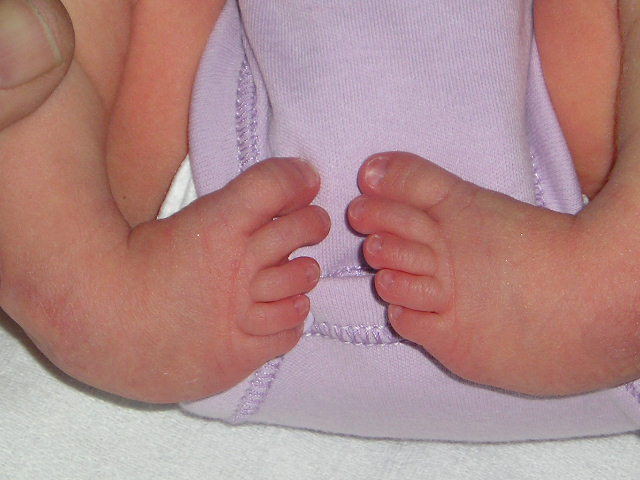Clubfoot: Symptoms, Causes, Treatment
What are the symptoms of clubfoot?
Clubfoot, also known as talipes equinovarus, is a congenital condition in which one or both feet are twisted inward and downward. The symptoms of clubfoot can vary depending on the severity of the condition, but common symptoms may include:
- Inward turning of the foot: The most obvious symptom of clubfoot is the inward turning of the foot, with the sole of the foot facing inward or downward.
- Abnormal shape of the foot: The affected foot may appear smaller and shorter than the other foot, with a higher arch and a heel that is turned inward.
- Stiffness of the foot: The foot may be stiff and difficult to move, especially in the direction opposite to the inward turn.
- Tightness of the Achilles tendon: The Achilles tendon, which runs from the calf muscle to the heel, may be tight and may prevent the foot from being moved into a normal position.
- Calf muscles may be underdeveloped: In some cases, the calf muscles of the affected leg may be smaller and weaker than those of the unaffected leg.
- Difficulty walking: Clubfoot can make it difficult for a child to walk normally, especially if the condition affects both feet.
Clubfoot is usually diagnosed shortly after birth based on a physical examination of the baby’s foot. Treatment for clubfoot is most effective when started early, often in the first few weeks of life. Treatment typically involves stretching and casting of the foot to gradually move it into a normal position. In some cases, surgery may be needed to correct the position of the foot. With early and appropriate treatment, most children with clubfoot can learn to walk normally and lead active lives.
What are the causes of clubfoot?
The exact cause of clubfoot is not known, but it is believed to be due to a combination of genetic and environmental factors. Some factors that may contribute to the development of clubfoot include:
- Genetics: Clubfoot tends to run in families, suggesting that there may be a genetic component to the condition. However, the exact genes involved have not been identified.
- Abnormalities in muscle or tendon development: Some researchers believe that clubfoot may be caused by abnormalities in the development of the muscles, tendons, and ligaments in the foot and leg.
- Position in the womb: It is thought that the position of the baby in the womb may play a role in the development of clubfoot. Babies who are positioned in a breech position (feet first) or who have less room to move in the womb may be more likely to develop clubfoot.
- Other factors: Some studies suggest that maternal smoking, maternal age (risks after age 35), and certain environmental factors may also increase the risk of clubfoot, but more research is needed to confirm these associations.
It’s important to note that clubfoot is not caused by anything that the parents did or did not do during pregnancy. It is a congenital condition, which means that it is present at birth, and it is not preventable. Early diagnosis and treatment by a healthcare provider are important for improving the outcome for children with clubfoot.
How common is clubfoot?
Clubfoot is a relatively common congenital deformity, occurring in approximately 1 in every 1,000 live births worldwide. It is more common in males than females, and it can affect one foot (unilateral) or both feet (bilateral). Clubfoot is one of the most common congenital musculoskeletal anomalies, but with early and appropriate treatment, the majority of children with clubfoot can achieve a good outcome and lead a normal, active life.
What is the treatment for clubfoot?
The treatment for clubfoot typically involves a series of steps that aim to gradually correct the position of the foot. The goal of treatment is to achieve a functional, pain-free foot that allows the child to walk normally. The main treatment options for clubfoot include:
- Ponseti method: The Ponseti method is the most common and widely used treatment for clubfoot. It involves a series of gentle stretching and casting of the foot to gradually move it into a corrected position. The foot is then placed in a brace to maintain the correction.
- Achilles tenotomy: In some cases, a minor surgical procedure called Achilles tenotomy may be needed to lengthen the Achilles tendon and allow for further correction of the foot. This procedure is usually done under local anesthesia and does not require a hospital stay.
- Bracing: After the initial correction is achieved, the child will need to wear a brace, usually at night, to maintain the correction and prevent the clubfoot from recurring. The brace is typically worn for several years.
- Physical therapy: Physical therapy may be recommended to help strengthen the muscles and improve the range of motion in the foot and ankle.
- Surgery: In some cases, if the clubfoot is severe or does not respond to other treatments, surgery may be needed to correct the position of the foot. Surgery is usually considered only after other treatments have been tried and have not been successful.
The Ponseti method has been shown to be highly effective in treating clubfoot, with success rates of over 90% in achieving a good functional outcome. However, early and consistent treatment is important for the best results. Untreated clubfoot can lead to significant functional limitations and deformity in adulthood.




